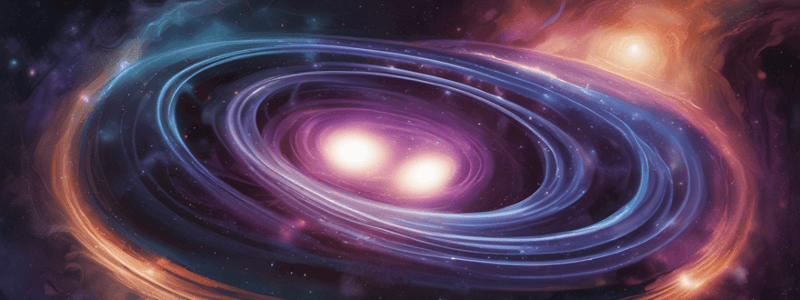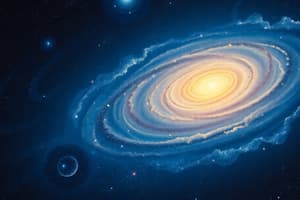Podcast
Questions and Answers
What is the main characteristic that differentiates spiral galaxies from elliptical galaxies?
What is the main characteristic that differentiates spiral galaxies from elliptical galaxies?
- Spiral galaxies have a central bar of stars. (correct)
- Spiral galaxies do not have a distinct shape.
- Spiral galaxies are the oldest type of galaxy.
- Spiral galaxies contain only old stars.
Which type of galaxy is characterized by having very little dust and gas, making it appear dim?
Which type of galaxy is characterized by having very little dust and gas, making it appear dim?
- Spiral galaxies
- Barred spiral galaxies
- Elliptical galaxies (correct)
- Irregular galaxies
What do we understand about the size and age of spiral galaxies in comparison to elliptical galaxies?
What do we understand about the size and age of spiral galaxies in comparison to elliptical galaxies?
- Spiral galaxies are larger and younger. (correct)
- Spiral galaxies are about the same size but older.
- Spiral galaxies are smaller and older.
- Spiral galaxies are larger and the oldest.
What is the primary reason elliptical galaxies can sometimes appear as a single bright star?
What is the primary reason elliptical galaxies can sometimes appear as a single bright star?
Which of the following statements is true regarding irregular galaxies?
Which of the following statements is true regarding irregular galaxies?
What occurs when celestial objects and solar systems collide within a galaxy?
What occurs when celestial objects and solar systems collide within a galaxy?
What distinguishes elliptical galaxies from spiral galaxies?
What distinguishes elliptical galaxies from spiral galaxies?
Which type of galaxy is known to contain a mix of both old and young stars?
Which type of galaxy is known to contain a mix of both old and young stars?
What defines spiral galaxies in terms of their structure?
What defines spiral galaxies in terms of their structure?
What is a primary characteristic of elliptical galaxies' star composition?
What is a primary characteristic of elliptical galaxies' star composition?
How do irregular galaxies differ in shape from elliptical and spiral galaxies?
How do irregular galaxies differ in shape from elliptical and spiral galaxies?
Which statement is true regarding the stars in spiral galaxies compared to elliptical galaxies?
Which statement is true regarding the stars in spiral galaxies compared to elliptical galaxies?
What characteristic do elliptical and spiral galaxies share?
What characteristic do elliptical and spiral galaxies share?
In which galaxy type is the presence of interstellar gas and dust the least prominent?
In which galaxy type is the presence of interstellar gas and dust the least prominent?
What is a galaxy primarily composed of?
What is a galaxy primarily composed of?
How is a light-year defined?
How is a light-year defined?
What initiates the formation of a galaxy according to the widely accepted model?
What initiates the formation of a galaxy according to the widely accepted model?
What role does gravity play in the formation of a protogalaxy?
What role does gravity play in the formation of a protogalaxy?
What process leads to the formation of solar nebulae or protostars within a galaxy?
What process leads to the formation of solar nebulae or protostars within a galaxy?
Which of the following best describes Earth's solar system's formation process?
Which of the following best describes Earth's solar system's formation process?
Flashcards are hidden until you start studying
Study Notes
Galaxy Overview
- Galaxies are vast collections of stars, planets, gases, dust, and other cosmic matter bound by gravity.
- An estimated 200 billion galaxies exist in the universe, varying in size from a few light-years to several hundred thousand light-years in diameter.
- A light-year equals approximately 5.8 trillion miles or 9.4 trillion kilometers, measuring the distance light travels in one year.
Galaxy Formation
- The widely accepted model posits that galaxies form from dense clouds of dust and cosmic matter that rotate and collapse under gravity into a protogalaxy.
- As the protogalaxy spins, small density fluctuations can lead to the creation of solar nebulae or protostars.
- The solar nebular theory explains the formation of Earth's solar system, where rotating matter shapes into a disk with a centralized concentration giving rise to a star, while remaining material forms planets and satellites.
Types of Galaxies
- Three main types of galaxies have been identified: elliptical, spiral, and irregular, primarily differentiated by their shapes.
Elliptical Galaxies
- Elliptical galaxies are believed to be among the oldest and most evolved, constituting about 33% of all galaxies.
- They exhibit either spherical or elongated shapes, characterized by older stars that have depleted gas and dust, making them appear dim.
- Stars in elliptical galaxies rotate in random orbits, leading to a lack of significant dust, which can cause them to resemble a single large star due to uniform light emission.
- Some ellipticals contain black holes at their center, contributing to the scarcity of dust and gas.
Spiral Galaxies
- Spiral galaxies have a distinct pinwheel shape with a central disk from which spiral arms extend.
- They can be classified as normal or barred; barred spirals feature a central bar of stars.
- The Milky Way is an example of a spiral galaxy and represents approximately 60% of all galaxies.
- Active star formation makes spiral galaxies appear bright and relatively young compared to elliptical counterparts.
Irregular Galaxies
- Irregular galaxies lack a distinct shape and are characterized by a significant presence of interstellar gases.
- They contain a mix of both young and old stars and are often formed from galaxy collisions or other chaotic stellar events.
Comparison of Galaxy Types
- Elliptical galaxies have either spherical or cucumber-like shapes versus the disk and arms of spiral galaxies.
- Stars in elliptical galaxies are older and dimmer, while spiral galaxies host younger and brighter stars.
- Irregular galaxies differ from both types by their undefined shape and the coexistence of both old and young stars.
Studying That Suits You
Use AI to generate personalized quizzes and flashcards to suit your learning preferences.




